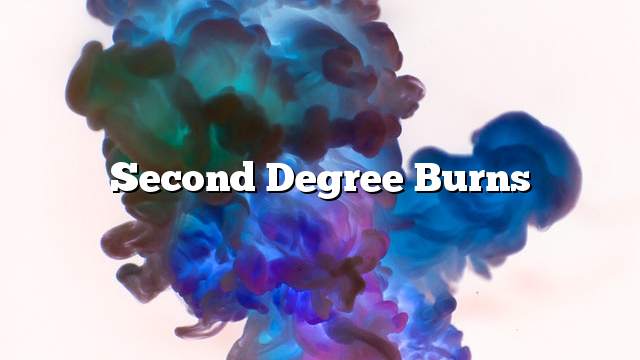Burns and their types
Burns are one of the most common home injuries, especially in children. Burns are not limited to pain and biting, but can cause severe damage to skin and skin, causing skin cells to die in the affected area. Although severe burns may require emergency measures to prevent complications, burns are often recovered without complications, taking into account the degree of incineration and the cause. The burns are divided into three main types depending on the degree of damage to the skin and skin: first-degree burns, the mildest damage, second-degree burns, third-degree burns (Third-Degree Burns), which is the most severe type of burns.
Second-degree burns and symptoms
Second-degree incineration is caused by the epidermis and part of the dermis. Second-degree burns are also known as Partial Thickness Burns. It is worth mentioning that the symptoms vary from one person to another, and may also be similar to the symptoms of other health problems, and the most important and most common symptoms:
- Be bubbles on the skin or so-called blisters.
- Deep redness.
- Wet and Shiny Appearance (Wet and Shiny Appearance).
- Feeling Pain When Touching Skin (Painful Skin).
- White or discolored burning area.
Second-degree burns
The most important causes of second-degree burns:
- Injuries from hot or boiled fluids.
- Injuries due to flame or fire.
- Friction skin with something hot for a simple.
- Sunburn.
- Chemicals.
- Electricity.
Treatment of second degree burns
Treatment varies depending on the intensity of the burn. The second class burns treatment has been classified as follows:
Treatment of minor burns
In cases where the diameter of the affected area does not exceed 7.62 cm, the burn is treated as a minor burn and is treated as follows:
- Cooling the affected area: In order to reduce pain by placing the affected area under cold water and running for ten to fifteen minutes, or by dipping a clean cloth and wet in cold water and put it on the affected area.
- Remove narrow sections: Such as rings etc, you should speed up doing it gently before the area swell.
- Do not open bubbles and pimples: Wash the affected area with soap and water gently in cases where pimples are opened, use an appropriate antibiotic, and cover the affected area with gauze and non-adhesive bandages.
- Use of moisturizers for the affected area: Such as aloe vera solutions and lotions, which may sometimes contribute to comfort.
- Use of analgesics when needed: Ibuprofen, naproxen sodium, and acetaminophen can be used if needed.
- Take tetanus vaccine: The tetanus tetanus should be updated every 10 years.
Treatment of large burns
Second-degree burns are major Burns if the diameter of the affected area is greater than 7.62 cm, or when incineration is covered for hands, feet, face, thigh, buttock, or any large joint. Emergency medical services, and until such time as they arrive, the following measures shall be taken:
- Protecting the injured from further damage: Be sure not to contact the infected material with burning, smoke and heat, and it is worth not to remove the clothes attached to the skin.
- Check for blood circulation signs: Such as breathing, coughing, and movement. Cardiopulmonary resuscitation should be initiated in cases where this is required.
- Do not drown large burns in cold water: To prevent hypothermia, decreased pressure, and lack of blood perfusion.
- Lift the affected area: Where it is preferable to raise the burned area to a higher level of heart if possible.
- Cover the affected area: Using a cold, wet cloth or using a clean cloth.
Second degree burns
Of the complications of burns of the second degree as follows:
- Infection: The skin acts as an insulator that protects the body from any external infection. However, this barrier may be damaged and broken. Thick scars may form in the case of severe burns, creating an environment suitable for bacterial growth, as well as difficult access of antibiotics. Antibiotics and Antibodies to the place of injury due to these scars.
- Shocking: The shock may be the result of low temperature or low blood volume. Regulation of fluid loss and regulation of body temperature are important functions of the skin. When a large area of the skin is burned, there is an increased chance of a decrease in blood volume. Severe Trauma increases the risk of hypothermia, which increases the risk of death if the patient is suffering from lactic acidosis and coagulopathy.
- Wound progress: Inflammation and reduction in the bloodstream of infected tissue can cause partial burns to become full thickness burn.
